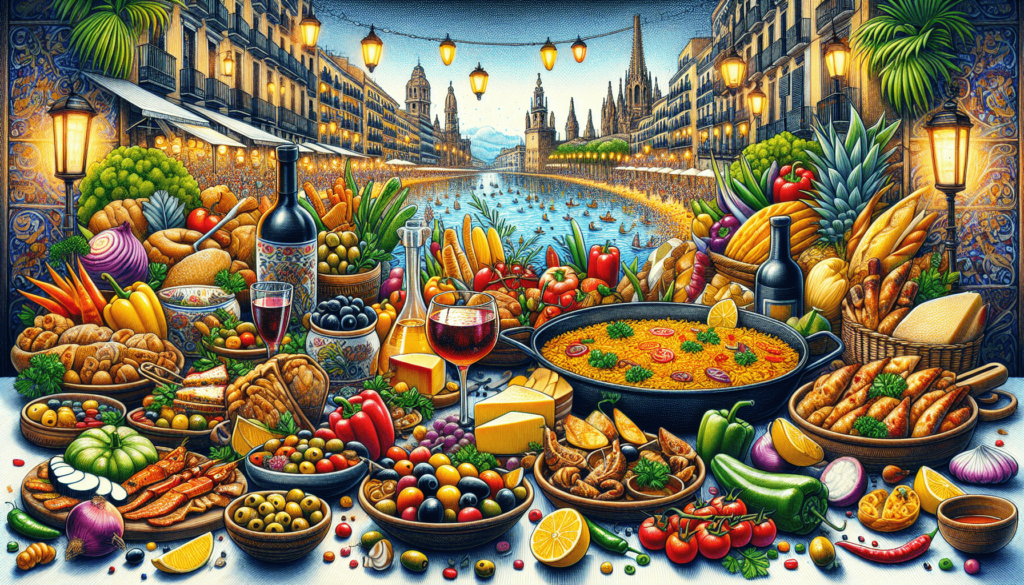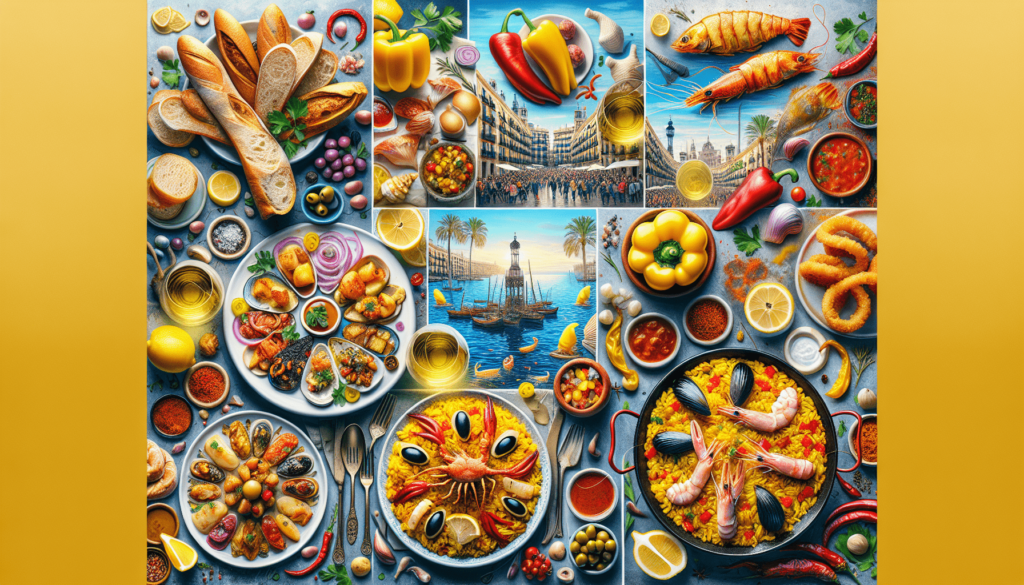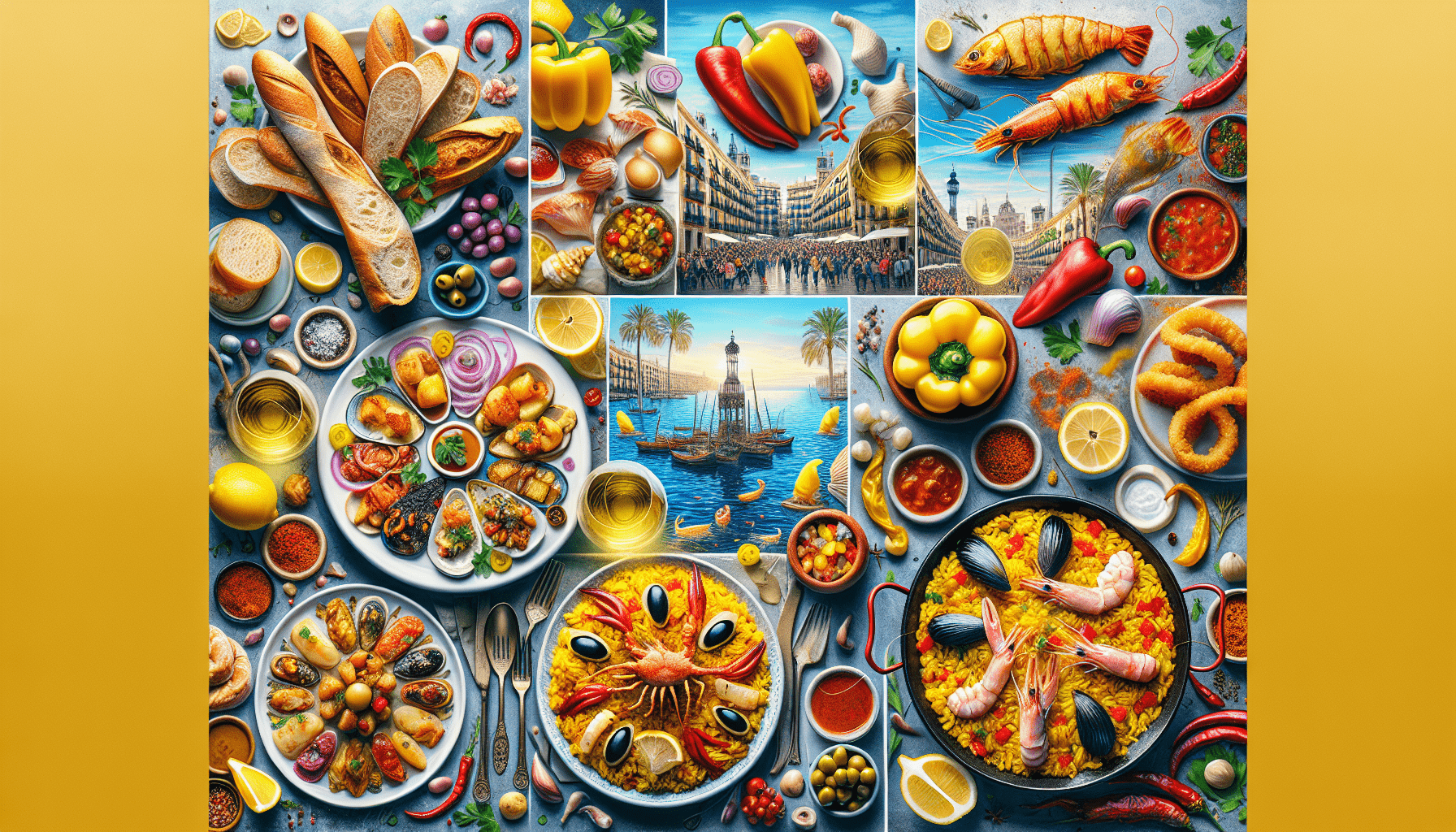A Culinary Tour Of Spain: From Tapas To Paella – Join us on a culinary adventure through the vibrant and diverse flavors of Spain, as we embark on a journey from the world-renowned tapas to the iconic paella. Spain’s gastronomic scene is a true reflection of its rich history and cultural diversity, offering a mouthwatering array of dishes that will leave you longing for more.
From the bustling streets of Barcelona to the charming coastal towns of Valencia, discover the secrets behind Spain’s most beloved dishes and indulge in the authentic flavors that have captivated food enthusiasts worldwide. Get ready to tantalize your taste buds and savor the essence of Spain, one bite at a time.
1. Introduction
Welcome to a comprehensive culinary tour of Spain! In this article, we will take you on a journey through the rich and vibrant flavors of Spanish cuisine. From the small bites of tapas to the iconic rice dish of paella, we will explore the unique and diverse dishes that make Spain a food lover’s paradise. So grab a seat at the table and get ready to experience the culinary delights that await you in Spain!
2. Tapas: A taste of Spain’s culinary culture
2.1 Origins of Tapas
Tapas, the small savory dishes that have become synonymous with Spanish cuisine, have a fascinating history. Legend has it that the concept of tapas originated centuries ago when Spanish bar owners began placing small plates of food on top of their customers’ drinks to prevent flies from landing on them. Over time, these small plates evolved into a culinary tradition, with each region in Spain adding its own twist to the concept.
2.2 Most Popular Tapas
When it comes to tapas, the options are endless. Some of the most popular tapas dishes include patatas bravas, which are crispy fried potatoes served with a spicy tomato sauce, and gambas al ajillo, which are succulent garlic prawns cooked in olive oil. Other favorites include croquetas, which are deep-fried breaded balls typically filled with ham or cheese, and tortilla española, a delicious Spanish omelette made with eggs, potatoes, and onions.
2.3 Where to Find Authentic Tapas
To truly experience the essence of tapas, it’s important to find authentic establishments that specialize in these delightful dishes. While tapas can be found throughout Spain, some regions are particularly renowned for their tapas culture. Cities like Barcelona, Madrid, and Seville offer a wide array of tapas bars where you can immerse yourself in the vibrant and lively atmosphere while indulging in these bite-sized delights. Remember to try different tapas bars, as each one may have its own unique specialties!

3. Paella: The iconic Spanish rice dish
3.1 History of Paella
No culinary tour of Spain would be complete without mentioning paella. This iconic rice dish has its roots in the Valencia region, where it originated in the 18th century. Originally a peasant’s meal, paella was cooked over an open fire in a wide, shallow pan called a paellera. Over time, it gained popularity and evolved into a beloved dish enjoyed by people from all walks of life.
3.2 Variations of Paella
While traditional paella consists of rice, saffron, vegetables, and meat or seafood, there are several variations of this beloved dish. One popular variation is paella de mariscos, which features an abundance of seafood such as prawns, mussels, and squid. Another variation is paella mixta, which combines both meat and seafood, often including chicken, rabbit, and various shellfish. Vegetarian options like paella de verduras are also available, showcasing the delicious flavors of seasonal vegetables.
3.3 Best Places to Try Paella
If you’re looking to indulge in an authentic paella experience, the best place to start is the city of Valencia itself. Here, you will find numerous restaurants specializing in this iconic dish, with each one claiming to have the best recipe. Another great destination for paella enthusiasts is the coastal town of Alicante, where you can enjoy a delicious paella while taking in the breathtaking views of the Mediterranean Sea. No matter where you are in Spain, be sure to seek out local recommendations and explore the regional variations of this delightful rice dish.
4. Jamón Ibérico: The pride of Spanish ham
4.1 What makes Jamón Ibérico special
When it comes to Spanish ham, none can rival the unparalleled taste and quality of Jamón Ibérico. Made from the meat of black Iberian pigs that roam freely in the oak forests of Spain, this cured delicacy is known for its intense flavor and melt-in-your-mouth texture. The pigs’ diet of acorns contributes to the unique nutty and savory notes that make Jamón Ibérico a true gourmet delight.
4.2 Different types of Jamón Ibérico
There are two main types of Jamón Ibérico: Jamón Ibérico de Bellota and Jamón Ibérico de Recebo. Jamón Ibérico de Bellota is considered the finest and most expensive variety, as it comes from pigs that have exclusively fed on acorns during the montanera season. This results in a rich and complex flavor profile. On the other hand, Jamón Ibérico de Recebo comes from pigs that have been fed a combination of acorns and grain. While still delicious, it offers a slightly milder taste compared to its Bellota counterpart.

5. Gazpacho: A refreshing Andalusian delight
5.1 Traditional ingredients and preparation
On a hot summer’s day, nothing beats the refreshing taste of gazpacho. Originating in the region of Andalusia in southern Spain, this chilled soup is made from fresh vegetables such as tomatoes, cucumbers, bell peppers, onions, and garlic. These ingredients are blended together with olive oil, vinegar, and bread to create a smooth and vibrant concoction. Gazpacho is the perfect way to cool down and revitalize your taste buds during the scorching Spanish summers.
5.2 Regional variations of Gazpacho
While the traditional recipe for gazpacho remains popular, there are several regional variations worth exploring. Salmorejo, for example, is a variation from the province of Cordoba that includes the addition of hard-boiled eggs and Serrano ham. Another variation is ajoblanco, a cold soup commonly found in the region of Malaga. Ajoblanco replaces tomatoes with almonds and is often served with grapes or melon, adding a unique twist to the classic gazpacho recipe.
6. Pintxos: The Basque Country’s small bites
6.1 Pintxos vs. Tapas
While similar to tapas in concept, pintxos have their origins in the Basque Country and offer a distinct culinary experience. Pintxos are typically small bites served on a slice of bread and held together with a toothpick or skewer. What sets pintxos apart is the focus on artistic presentation and the variety of ingredients used. From fresh seafood to cured meats, each pintxo is a miniature work of art that reflects the Basques’ passion for gastronomy.
6.2 Popular Pintxos ingredients
Pintxos offer a wide variety of flavors and textures, with ingredients ranging from seafood to vegetables and everything in between. Some popular pintxos include gilda, a combination of a chili pepper, an anchovy fillet, and a green olive skewered together, and txalupa, which features a small boat-shaped pastry filled with various fillings such as crab or cod. Other common ingredients found in pintxos include jamón Ibérico, Spanish cheese, and marinated vegetables.
6.3 Where to experience Pintxos culture
To fully immerse yourself in the pintxos culture, head to the vibrant city of San Sebastian in the Basque Country. Here, you will find numerous pintxos bars offering a wide selection of these delightful bite-sized creations. The old town, known as Parte Vieja, is particularly famous for its pintxos bars, where you can hop from one establishment to another, sampling the different flavors and combinations. The Basque Country is also home to Bilbao, another city renowned for its pintxos scene, making it a must-visit destination for food enthusiasts.
7. Churros: Spain’s sweet fried dough
7.1 History and cultural significance of Churros
When it comes to sweet treats in Spain, churros take center stage. This beloved pastry has a long and storied history. Originally introduced to Spain by the Moors during their occupation, churros quickly became a popular street food, particularly during festivals and celebrations. Today, they are enjoyed as a breakfast or snack, often paired with a cup of thick hot chocolate for dipping.
7.2 Best ways to enjoy Churros
Churros are best enjoyed when fresh and piping hot. Whether you prefer them straight or curled into a loop, their crispy exterior and soft, doughy interior make for a delightful combination. For an authentic churros experience, head to a churrería, a dedicated café that specializes in these delicious treats. Enjoy your churros sprinkled with sugar or dipped in rich hot chocolate, and savor every bite of this sweet indulgence.
8. Sangria: Spain’s famous fruity wine punch
8.1 Origins and traditional ingredients
No culinary tour of Spain would be complete without mentioning sangria, the country’s famous fruity wine punch. Originating in Spain, sangria has become a beloved drink enjoyed all over the world, particularly during the summer months. Traditionally made with red wine, chopped fruit, sugar, and a splash of brandy, sangria is a refreshing and flavorsome beverage that perfectly complements Spain’s vibrant culinary delights.
8.2 Variations and serving styles of Sangria
While traditional red sangria remains popular, variations of this classic drink have emerged over the years. White sangria, made with white wine instead of red, offers a lighter and fruitier alternative. Sparkling sangria, which incorporates sparkling wine or champagne, adds a touch of elegance and effervescence. Additionally, there are numerous regional variations of sangria, each one featuring local fruits and flavors. Sangria is typically served in large pitchers, making it perfect for sharing with friends and loved ones.
9. Tortilla Española: A classic Spanish omelette
9.1 Essential ingredients and cooking technique
Tortilla Española, also known as Spanish omelette, is a classic dish that can be found in nearly every corner of Spain. This simple yet satisfying dish is made with just a few ingredients – eggs, potatoes, onions, and olive oil. The key to a perfect tortilla Española lies in the cooking technique. The potatoes and onions are first sautéed until tender, then mixed with beaten eggs and cooked slowly in a pan until the omelette is set and golden brown.
9.2 Popular regional variations of Tortilla Española
While the basic recipe for tortilla Española remains the same throughout Spain, there are regional variations that add their own unique twist to this classic dish. In Catalonia, for example, you will find tortilla de patatas con cebolla, which includes both potatoes and onions. In the Basque Country, tortilla Vasca features the addition of cooked red peppers and peas, adding a burst of color and flavor. Exploring these regional variations allows you to discover the diverse interpretations of this beloved Spanish staple.
10. Percebes: Unique delicacy from Galicia
10.1 Introduction to Percebes
Our culinary tour of Spain wouldn’t be complete without mentioning percebes, a unique delicacy from the coastal region of Galicia. Percebes, also known as gooseneck barnacles, are harvested from the rocky cliffs along the Atlantic coast. They have a distinct appearance with a long, black stalk and a small, reddish shell. These unusual-looking creatures may seem intimidating, but the reward lies in their exquisite taste.
10.2 Harvesting and cooking Percebes
Harvesting percebes is a dangerous and challenging task. Percebeiros, the brave individuals who collect them, risk their lives navigating treacherous cliffs and strong ocean currents. Once harvested, the gooseneck barnacles undergo a simple cooking process. They are boiled briefly in seawater to preserve their natural flavors before being served as a delicacy.
10.3 Where to try Percebes
To truly experience the unique flavors of percebes, a visit to the coastal towns of Galicia is a must. Places like Cambados and Vigo are known for their fresh seafood and are perfect destinations to indulge in this Galician delicacy. Local seafood markets and traditional seafood restaurants are the best places to find percebes, allowing you to witness the passion and dedication that goes into bringing this unique delicacy from the sea to your plate.
A Culinary Tour Of Spain: From Tapas To Paella
As you wrap up your culinary tour of Spain, you will have experienced the rich and diverse flavors that make Spanish cuisine truly extraordinary. From the bite-sized delights of tapas and pintxos to the bold and complex flavors of paella and Jamón Ibérico, Spain offers a culinary adventure like no other. So pack your bags and embark on a journey filled with mouthwatering dishes, unforgettable flavors, and warm hospitality. ¡Buen provecho! (Bon appétit!).
We hope we have helped you on your journey to experience and taste your way around Spain! If so, why not check out another of our articles, ‘A Foodie’s Guide To The Best Street Eats In Mexico City‘.

